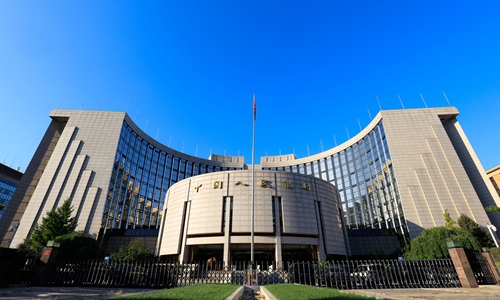
A view of the PBC's headquarters in Beijing Photo: cnsphoto
China stood pat on its benchmark lending rate - loan prime rate (LPR) - for the 19th straight month at its November fixing, largely in line with market expectations, reflecting stability in China's monetary policy despite external pressures.
But some analysts said that China will likely make another Reserve Requirement Ratio (RRR) cut before the end of this year to cope with an economic slowdown, though the benchmark lending rate is unlikely to change this year.
The one-year LPR remained at 3.85 percent, while the five-year LPR remained at 4.65 percent, according to data released by the National Interbank Funding Center on Monday.
The LPR is a lending reference rate set monthly by 18 banks, which submit a monthly quotation by adding a premium over the Medium-term Lending Facility rate. It is also seen as the de facto benchmark reference rate for lending by Chinese banks.
China has kept the LPR unchanged for nearly 20 months. The last time that the country adjusted the LPR was in April 2020, when the one-year LPR was cut from 4.05 percent to 3.85 percent.
The LPR stance was mostly in line with market expectations, as 21 out of 23 participants in a recent Reuters poll expected no change in either rate, according to a Reuters report in November.
The unchanged LPR also reflected stability in China's monetary policy despite external pressure. The IMF has recently pressed China to address its financial risks in a "clear and coordinated fashion" and temporarily shift its fiscal policy to a neutral stance from this year's "contractionary" approach.
According to the third-quarter monetary policy report recently released by the People's Bank of China (PBC), the central bank, China's monetary policy stance will be "flexible and precisely targeted, appropriate and moderate." It also noted that China will conduct cross-cyclical adjustments and enhance the forward-looking nature of its monetary policy.
Such expressions show that the PBC will make more arrangements and reserve plans in advance to cope with downward economic pressure at the end of this year and early next year, and it will increase the strength of support measures "at any time," according to a report released by Chasing Securities.
Xi Junyang, a professor at the Shanghai University of Finance and Economics, said that the central bank will likely cut the RRR, the amount of cash that banks and financial institutions must hold as reserves, by 25 basis points before the end of this year.
"The RRR cut is necessary as the government needs to cope with the economic slowdown fueled by a mixture of factors, including the COVID-19 resurgence and real estate controls. Besides, China's capital supply growth is at a relatively low level, providing space for cutting the RRR," he told the Global Times on Monday.
Chasing Securities analysts, however, insisted that China would prefer structural monetary policy tools like relending facilities, and it's possible that China will further increase the strength of such tools.
This year, China has newly launched about 1 trillion yuan ($157 billion) of structural monetary policy tools, including
200 billion yuan of relending facilities for the clean use of coal, as well as
200 billion yuan of relending facilities to support balanced regional development.
However, experts agreed that China is unlikely to change the benchmark lending rate this year.
"The unchanged LPR in November shows that the PBC agrees with the current interest rate level in the credit market, as financial data show that these figures are within a reasonable range. Besides, banks are not motivated to lower the credit rate, while keeping the LPR unchanged will help stabilize market expectations for the property market," Zhou Maohua, a macroeconomics analyst under the financial market division of Everbright Bank, told the Global Times on Monday.
Wu Chaoming, chief analyst of Chasing Securities, told the Global Times that since inflation is still at a relatively high level, the timing of interest rate cuts will likely be delayed, and structural adjustment will remain the mainstream mode for the time being.




